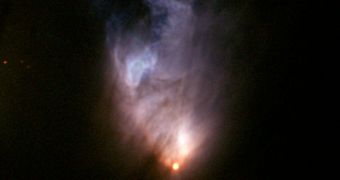Located around 1,300 light-years away, in the constellation Orion, the celestial object known as V1647 Orionis is a star that is only now catching shape and which will not be completely formed for at least several million years. Astronomers have recently been able to observe it as it produced intense X-rays.
Scientists never had too many opportunities to study still-forming stars, but this particular object provides them with unique data. They have recently been able to observe a phenomenon that usually accompanies protostar development.
One of the most important things the study revealed is that the star is rotating extremely rapidly as it accumulates matter. A series of extremely intense magnetic fields are driving material from the remnants of the former hydrogen gas clouds that spawned the protostar right into the object's surface.
As a direct consequence, impressively large areas of the protostar are heated to temperatures of several millions of degrees, up to the point where they begin to emit X-rays. This object was first discovered back in January 2004.
Observations were conducted using the NASA Chandra X-ray Observatory (CXO), the Japan Aerospace Exploration Agency (JAXA) Suzaku spacecraft, and the European Space Agency's (ESA) XMM-Newton telescope.
“Based on infrared studies, we suspect that this protostar is no more than a million years old, and probably much younger,” explains the lead author of the new study, NASA Goddard Space Flight Center (GSFC) astrophysicist Kenji Hamaguchi.
Much of the protostar's shine, astronomers determined, comes from the heat generated by the massive volumes of gas that are making their way onto its surface. V1647 Orionis is not yet developed enough to support the nuclear fusion of hydrogen isotopes at its core.
Though five times larger than the Sun, the object has only 80 percent of a solar mass, and is a lot less dense than our own star. Its surface is about 33 percent cooler than the Sun's, at only 3,500 degrees Celsius (6,400 degrees Fahrenheit).
“V1647 Ori gave us the first direct evidence that a protostar surges in X-ray activity as its rate of mass accretion rises,” explains study coauthor Nicolas Grosso, who is an astrophysicist at the French National Center for Scientific Research (CNRS).
“Considering that V1647 Ori is about five times the size of the sun, the rapid spin confirms that we're watching a young stellar object that is in the process of pulling itself together,” Rochester Institute of Technology professor of imaging science and astronomical sciences and technology, Joel Kastner, says.

 14 DAY TRIAL //
14 DAY TRIAL //